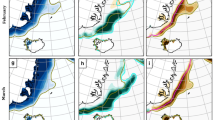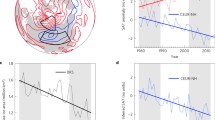Abstract
Published reconstructions of last glacial maximum (LGM) sea surface temperatures and sea ice extent differ significantly. We here test the sensitivity of simulated North Atlantic climates to two different reconstructions by using these reconstructions as boundary conditions for model experiments. An atmospheric general circulation model has been used to perform two simulations of the (LGM) and a modern-day control simulation. Standard (CLIMAP) reconstructions of sea ice and sea surface temperatures have been used for the first simulation, and a set of new reconstructions in the Nordic Seas/Northern Atlantic have been used for the second experiment. The new reconstruction is based on 158 core samples, and represents ice-free conditions during summer in the Nordic Seas, with accordingly warmer sea surface temperatures and less extensive sea ice during winter as well. The simulated glacial climate is globally 5.7 K colder than modern day, with the largest changes at mid and high latitudes. Due to more intense Hadley circulation, the precipitation at lower latitudes has increased in the simulations of the LGM. Relative to the simulation with the standard CLIMAP reconstructions, reduction of the sea ice in the North Atlantic gives positive local responses in temperature, precipitation and reduction of the sea level pressure. Only very weak signatures of the wintertime Icelandic Low occur when the standard CLIMAP sea surface temperature reconstruction is used as the lower boundary condition in LGM. With reduced sea ice conditions in the Nordic Seas, the Icelandic Low becomes more intense and closer to its present structure. This indicates that thermal forcing is an important factor in determining the strength and position of the Icelandic Low. The Arctic Oscillation is the most dominant large scale variability feature on the Northern Hemisphere in modern day winter climate. In the simulation of the LGM with extensive sea ice this pattern is significantly changed and represents no systematic large scale variability over the North Atlantic. Reduction of the North Atlantic sea ice extent leads to stronger variability in monthly mean sea level pressure in winter. The synoptic variability appears at a lower level in the simulation when standard reconstructions of the sea surface in the LGM are used. A closer inspection of storm tracks in this model experiment shows that that the synoptic lows follow a narrow band along the ice edge during winter. The trajectories of synoptic lows are not constrained to the sea ice edge to the same degree when the sea ice extent is reduced. Seasonally open waters in the Nordic Seas in the new reconstruction apparently act as a moisture source, consistent with the current understanding of the rapid growth of the Fennoscandian and Barents Ice Sheets, during the LGM. The signal from the intensified thermal forcing in the North Atlantic in Boreal winter is carried zonally by upper tropospheric waves, and thus generates non-local responses to the changed sea ice cover.













Similar content being viewed by others
References
Bentsen M, Drange H, Furevik T, Zhou T (2004) Simulated variability of the Atlantic meridional overturning circulation. Clim Dyn 22:701–720
Bonfils CJ, Lewden D, Taylor KE (1998) Documentation of the PMIP models. PCMDI Report, http://www.pcmdi.llnl.gov/pmip
Boulton GS (1979) Glacial history of the spitsbergen archipelago and the problem of a barents shelf ice sheet. Boreas 8:31–57
CLIMAP (1981) Seasonal reconstruction of the Earth’s surface at the last glacial maximum. Series, Map and Chart vol. 36. Geologocal Society of America, 18 pp
Dai A, Fung IY, DelGenio AD (1997) Surface observed global land precipitation variations during 1900–88. J Clim 10:2943–2962
Denton GH, Hughes TJ (eds) (1981) The last great ice sheets. Wiley, New York, pp 484
Deque M, Dreveton C, Braun A, Cariolle D (1994) The arpege/Ifs atmosphere model – a contribution to the french community climate modeling. Clim Dyn 10:249–266
Deque M, Marquet P, Jones RG (1998) Simulation of climate change over Europe using a global variable resolution general circulation model. Clim Dyn 14:173–189
Deque M, Piedelievre JP (1995) High-Resolution climate simulation over Europe. Clim Dyn 11:321–339
Dong B, Valdes PJ (1998) Simulations of the last glacial maximum climates using a general circulation model: prescribed versus computed sea surface temperatures. Clim Dyn 14:571–591
Elverhoi A, Svendsen JI, Solheim A, Andersen ES, Milliman J, Mangerud J, Hooke RL (1995) Late quaternary sediment yield from the high arctic svalbard area. J Geol 103:1–17
Hall NMJ, Valdes PJ, Dong BW (1996) The maintenance of the last great ice sheets: a UGAMP GCM study. J Clim 9:1004–1019
Hebbeln D, Dokken T, Andersen ES, Hald M, Elverhoi A (1994) Moisture supply for northern ice-sheet growth during the last glacial maximum. Nature 370:357–360
Hodges KI (1994) A general-method for tracking analysis and its application to meteorological data. Mon Weather Rev 122:2573–2586
Hodges KI (1995) Feature tracking on the unit-sphere. Mon Weather Rev 123:3458–3465
Hodges KI (1996) Spherical nonparametric estimators applied to the UGAMP model integration for AMIP. Mon Weather Rev 124:2914–2932
Hodges KI (1999) Adaptive constraints for feature tracking. Mon Weather Rev 127:1362–1373
Hoskins BJ, Karoly DJ (1981) The steady linear response of a spherical atmosphere to thermal and orographic forcing. J Atmos Sci 38:1179–1196
Hurrell JW (1995) Decadal trends in the north-atlantic Oscillation – regional temperatures and precipitation. Science 269:676–679
Hurrell JW, VanLoon H (1997) Decadal variations in climate associated with the north Atlantic oscillation. Clim Change 36:301–326
Joussaume S, Taylor KE (1995) Status of the paleoclimate modeling intercomparison project (PMIP). In: Proceedings of the first international AMIP scientific conference. WCRP Report, pp 425–430
Joussaume S, Taylor KE (2001) The paleoclimate modelling intercomparison project. In: Proceedings of the third PMIP Workshop, WCRP report WCRP-111, pp 43–49
Kushnir Y, Robinson WA, Blade I, Hall NMJ, Peng S, Sutton R (2002) Atmospheric GCM response to extratropical SST anomalies: synthesis and evaluation. J Clim 15:2233–2256
Kutzbach JE (1988) Climatic changes of the last 18,000 years - observations and model simulations. Science 241:1043–1052
Lautenschlager M, Herterich K (1990) Atmospheric response to ice-age conditions – climatology near the earths surface. J Geophys Res-Atmos 95:22547–22557
Mangerud J, Astakhov V, Svendsen JI (2002) The extent of the Barents-Kara ice sheet during the last glacial maximum. Quaternary Sci Rev 21:111–119
Meland MY, Jansen E, Elderfield H (2005) Constraints on SST estimates for the northern North Atlantic/Nordic seas during the LGM. Quaternary Sci Rev 24(7–9):835–852
North GR, Bell TL, Cahalan RF, Moenig FJ (1982) Sampling errors in the stimation of empirical orthogonal functions. Mon Weather Rev 110:699–706
Peltier WR (1994) Ice-age paleotopography. Science 265:195–201
Pflaumann U, Duprat J, Pujol C, Labeyrie LD (1996) SIMMAX: a modern analog technique to deduce Atlantic sea surface temperatures from planktonic foraminifera in deep-sea sediments. Paleoceanography 11:15–35
Pflaumann U, Sarnthein M, Chapman M, d’Abreu L, Funnell B, Huels M, Kiefer T, Maslin M, Schulz H, Swallow J, van Kreveld S, Vautravers M, Vogelsang E, Weinelt M (2003) Glacial North Atlantic: sea-surface conditions reconstructed by GLAMAP 2000. Paleoceanography 18(3):1065
Pinot S, Ramstein G, Marsiat I, de Vernal A, Peyron O, Duplessy JC, Weinelt M (1999) Sensitivity of the European LGM climate to North Atlantic sea-surface temperature. Geophys Res Lett 26:1893–1896
Reynolds RW, Smith TM (1995) A high-resolution global sea-surface temperature climatology. J Clim 8:1571–1583
Rogers JC (1997) North Atlantic storm track variability and its association to the north Atlantic oscillation and climate variability of northern Europe. J Clim 10:1635–1647
Rosell-Mele A, Comes P (1999) Evidence for a warm last glacial maximum in the Nordic seas or an example of shortcomings in U-37(K)’ and U-37(K) to estimate low sea surface temperature? Paleoceanography 14:770–776
Sarnthein M, Jansen E, Weinelt M, Arnold M, Duplessy JC, Erlenkeuser H, Flatoy A, Johannessen G, Johannessen T, Jung S, Koc N, Labeyrie L, Maslin M, Pflaumann U, Schulz H (1995) Variations in atlantic surface ocean paleoceanography, 50-Degrees-80-Degrees-N - A time-slice record of the last 30,000 years. Paleoceanography 10:1063–1094
Shin SI, Liu Z, Otto-Bliesner B, Brady EC, Kutzbach JE, Harrison SP (2003) A simulation of the last glacial maximum climate using the NCAR-CCSM. Clim Dyn 20:127–151
Thompson DWJ, Wallace JM (1998) The Arctic oscillation signature in the wintertime geopotential height and temperature fields. Geophys Res Lett 25:1297–1300
Trenberth KE, Hurrell JW (1994) Decadal atmosphere-ocean variations in the Pacific. Clim Dyn 9:303–319
de Vernal A, Hillaire-Marcel C, Turon JL, Matthiessen J (2000) Reconstruction of sea-surface temperature, salinity, and sea-ice cover in the northern North Atlantic during the last glacial maximum based on dinocyst assemblages. Can J Earth Sci 37:725–750
Veum T, Jansen E, Arnold M, Beyer I, Duplessy JC (1992) Water mass exchange between the North-Atlantic and the norwegian sea during the past 28,000 years. Nature 356:783–785
Wagner T, Henrich R (1994) Organo- and lithofacies of TOC-lead glacial/interglacial deposits in the Norwegian-Greenland Sea: sedimentary and diagenetic responses to paleoceanographic and paleoclimatic changes. Mar Geol 120:335–364
Wallace JM, Gutzler DS (1981) Teleconnections in the geopotential height field during the northern hemisphere winter. Mon Weather Rev 109:784–812
Weinelt M, Sarnthein M, Pflaumann U, Schulz H, Jung SJA, Erlenkeuser H (1996) Ice-free Nordic seas during the last glacial maximum? Potential sites of deepwater formation. Paleoclimates 1:283–309
Acknowledgements
This work has been supported by Faculty of Mathematics and Natural Sciences, University of Bergen and by MACESIZ, Marine Climate and Ecosystems in the Seasonal Ice Zone, founded by the Research Council of Norway. This is publication number A 112 from the Bjerknes Centre for Climate Research.
Author information
Authors and Affiliations
Corresponding author
Rights and permissions
About this article
Cite this article
Byrkjedal, Ø., Kvamstø, N.G., Meland, M. et al. Sensitivity of last glacial maximum climate to sea ice conditions in the Nordic Seas . Clim Dyn 26, 473–487 (2006). https://doi.org/10.1007/s00382-005-0096-2
Received:
Accepted:
Published:
Issue Date:
DOI: https://doi.org/10.1007/s00382-005-0096-2




